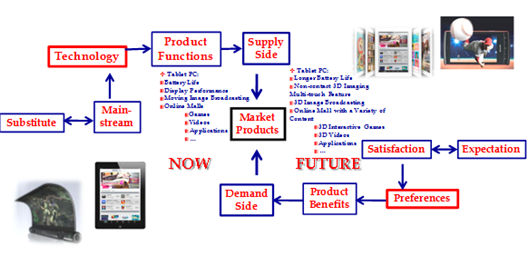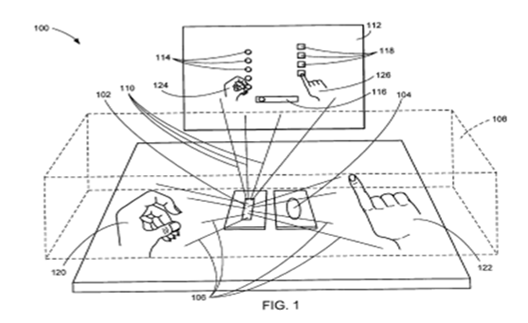MIC Perspective
Online Entertainment Becoming Key Product Benefit for Tablet PC
After obtaining price tags and product benefits of eight mainstream tablet PCs from five major tablet PC vendors, a multiple linear regression analysis model with dummy variables is built to calculate the ¡µR2 of each independent variable. ¡µR2 values determine which product benefits can best interpret price differences of tablet PCs. T The calculation allows us to outline key features that vendors focus on and shed the light to how branded vendors will define the competitive positioning of their tablet products.
SPSS statistical analysis software is used to perform quantitative calculation of independent variables'? ¡µR2 values using a multiple linear regression analysis model with dummy variables.
19 out of 51 dummy variables are designated as product benefits and explanatory power of those product benefits with respect to the price of eight mainstream products will be deemed positively significant when their ¡µR2 values are larger than 0. Primary benefits include long battery life, online stores for consumers to download a variety of digital content, faster digital content download, graphics performance, and display performance. These primary benefits were then redefined as the download of digital content and engagement in entertainment activities through Internet connection.
Some product benefits lead to price upward or downward, causing the price of products to deviate from the expected price line. These benefits are defined as secondary benefits, including memory card expansion slot, thinner, lighter body and feels even more comfortable in hands, larger display size, optional keyboard docking station, and built-in Office solution for users to view, edit, create Office documents.
From consumers' point of view, non-stop online entertainment is what they look for in tablet PCs. Long battery life, online stores for consumers to download a variety of digital content, and graphics performance are deemed as primary benefits.
The finding indicates that the multi-touch feature does not have explanatory power with respect to the price of mainstream tablet PCs. In other words, 206 consumers surveyed did not think the product benefit of multi-touch technology in tablet PC models that enables intuitive operations is significant.
That is, the multi-touch technology has been widely adopted and thus has become a standard feature; as a result, the multi-touch feature is no longer a major growth driver for tablet PCs. This explains Apple's aggressive move in filing patent infringement lawsuits against rivals. Since Apple's rivals have released products with iPad-like product benefits, it is expected that the uniqueness of iPad's product benefits will fade at a rather fast pace.
MIC has been paying close attention to Apple's patent applications and approval results in the United States. On September 13, 2011, Apple had a series of 13 newly granted patents including patent number 8,018,579 for a versatile 3D imaging and display system. The patent was filed by Apple on October 21, 2005 and was approved and published six years later.
It is anticipated that in the near future, new iPad models will be equipped with this new 3D gesture patent technology, allowing users to play 3D interactive games on iPad through multi-touch operations. Apple's release of the new model is projected to trigger another wave of tablet PC replacement demand in the market.
|
Figure 7
|
Anticipated Product Benefits of Future Tablet PCs
|
|

|
|
Source: MIC, April 2012
|
| |
|
|
Figure 8
|
Apple's 3D Gesture Patent US 8,018,579
|
|

|
|
Source: USPTO, MIC, April 2012
|
| |
|
Product Differentiation between Tablet PCs and Notebook PCs Becoming More Prominent
After performing a statistical analysis of benefits and price tags of the eight mainstream models, the finding indicates that the built-in Office solution for users to view, edit, create Office documents and optional keyboard docking station are the product benefits that consumers believe those products will bring them at work. Even though the ¡µR2 values of the abovementioned two product benefits are positive, they both have negative beta values.
In other words, consumers literally believe that vendors cannot increase the price tag of a tablet PCs equipped with the abovementioned product specs or functions.
Therefore, those two product benefits have significantly negative explanatory power with respect to price differences among tablet PCs.
Product benefits for entertainment include online stores for consumers to download a variety of digital content, faster digital content download, and graphics performance. Both ¡µR2 and beta values of those three product benefits are positive.
The results show that consumers literally believe that a tablet PC equipped with the abovementioned three specs or features will bring product benefits that promise high satisfactory and therefore consumers are more likely to accept prices of those tablet PCs.
It can be seen that these product benefits have positive explanatory power with respect to the prices of those mainstream tablet PC models.
However, looking at consumers' belief in product benefits for tablet and notebook PCs, it is observed that tablet PCs are used for entertainment instead of for work. Therefore, the boundary between tablet PCs and notebook PCs is becoming more distinct. Consumers are able to have mobile entertainment via a tablet PC and use a notebook PC to help them complete more complicated tasks at work.
Appendix
Research Scope
This report examines product catalogues, technical specs manuals, and user manuals of eight tablet PCs released by five key vendors. The five tablet PC vendors include Apple, Asus, Acer, HTC, and Samsung. 206 valid samples of consumers' reviews and feedback on product benefits of the eight tablet PCs are gathered. Through running multiple linear regression analysis model with dummy variables, statistical analysis is performed for tablet PC price tags and product benefits. The model defines the key product benefits that leads to different price tags among tablet PCs as well as reflects consumers' demand and preferences for tablet PCs, key vendors' promotions for tablet PC specs or functions, and product competitive positioning and deployment strategies.
Glossary of Terms
|
SPSS
|
|
Statistical Product and Service Solutions
|
List of Companies
|
Acer
|
|
宏碁
|
|
AMD
|
|
|
|
Apple
|
|
|
|
Asus
|
|
華碩
|
|
Dell
|
|
|
|
HP
|
|
|
|
HTC
|
|
宏達電
|
|
MIC (Market Intelligence & Consulting Institute)
|
|
資策會產業情報研究所
|
|
Motorola
|
|
|
|
Nokia
|
|
|
|
Nvidia
|
|
|
|
Qualcomm
|
|
|
|
Samsung
|
|
|
|
Sony
|
|
|
|
USPTO (United States Patent and Trademark Office)
|
|
|